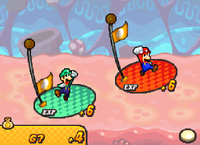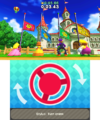Flagpole
- This article is about flagpoles in general. For the specific flagpoles that mark the ends of stages, see Goal Pole.
| Flagpole | |||
|---|---|---|---|
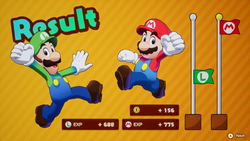 Mario and Luigi with flagpoles in Mario & Luigi: Brothership | |||
| First appearance | Super Mario 64 (1996) | ||
| Latest appearance | Mario & Luigi: Brothership (2024) | ||
| Variant of | Pole | ||
| |||
Flagpoles[1] are objects that are seen in several games of the Super Mario franchise. A majority of them take inspiration from the Goal Poles (themselves often just called "flagpoles" or "poles") located at the end of stages in Super Mario Bros. and most of the platforming games following New Super Mario Bros. Some of these even appear at the ends of stages, but are not the specific stage goal themselves. Most of the time, they can be climbed like typical poles. What sets flagpoles apart from Goal Poles is the lack of certain mechanics, especially points for landing on them and the level ending immediately after activating them.
History
Super Mario series
Super Mario 64
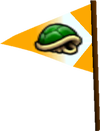
During the development of Super Mario 64, the traditional level-end flagpoles were considered to be used for stage goals,[2] but were replaced with Power Stars to better fit with the game's 3D sandbox style. The only flagpoles are yellow with an image of a Koopa Shell, which take up most of the poles and are much shorter than the goal-type poles. They are the goal points for Koopa the Quick's races, can be climbed like miscellaneous poles and trees, and vaulted off of from the top.
Super Mario Sunshine
The flagpoles in Super Mario Sunshine had their height adjusted to be in-line with the traditional goal flagpoles from the 2D games. The flag is now red and depicts a blue Pianta, though remains a lot larger than the pole. They are based on the flagpoles on Super Mario 64, with their purpose being only to mark the end of races, specifically against Il Piantissimo.
Super Mario Galaxy
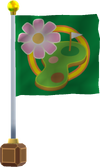
Flagpoles are featured at the end of Rolling Ball segments in Super Mario Galaxy. They are depicted green and have a picture of a golf course. The pole and the block it is attached to are intended to be visually reminiscent of the goal flagpoles in Super Mario Bros., although they are much smaller. Mario retains the ability to climb flagpoles. Bowser Jr.'s Airship Armada has similar poles, except these lack any flag.
Super Mario Galaxy 2
Flagpoles are featured in different capacities in Super Mario Galaxy 2. They sport a Bowser-themed Jolly Roger, and are located in Bowser's Lava Lair, Bowser Jr.'s Boom Bunker, and the Throwback Galaxy. Either a Life Mushroom or a 1-Up Mushroom can often be found on top of a flagpole. The poles at the end of Star Ball segments now lack flags and have cannon shots at the top.
Mario Party series
In Crank to Rank, a minigame in Mario Party 8 and reintroduced in Mario Party: The Top 100, there are flagpoles with the Star Carnival emblem.
Mario & Luigi series
As of Mario & Luigi: Bowser's Inside Story, when Mario, Luigi, Bowser (in Mario & Luigi: Bowser's Inside Story), or Paper Mario (in Mario & Luigi: Paper Jam) gain Experience Points, flagpoles appear as the EXP meter; when the flag gets to the top of the pole, they level up. In Mario & Luigi: Bowser's Inside Story, the flags on each pole are yellow, and rectangular-shaped with mushroom emblems. Starting with Mario & Luigi: Dream Team, and following Mario & Luigi games, the flags are swallowtail-shaped, and bear Mario and Luigi's respective colors and emblems. Bowser's flagpole in Mario & Luigi: Bowser's Inside Story bears a black, spiked truck, and his flag is a dark gray flag with three tips that bears his red emblem; in Mario & Luigi: Bowser's Inside Story + Bowser Jr.'s Journey, Bowser's flagpole has a standard yellow truck, and his flag has the same swallowtail shape as Mario and Luigi, colored black and still bearing his emblem. Paper Mario's flag in Mario & Luigi: Paper Jam is yellow and bears a yellow "P" emblem. In earlier games, the poles are round and crooked, though in Mario & Luigi: Brothership, they are perfectly straight and thus more resemble Goal Poles.
Gallery
Naming
Internal names
| Game | File | Name | Meaning
|
|---|---|---|---|
| Super Mario 64 DS | data/normal_obj/obj_race_flag/ | RACE_FLAG | Race Flag |
| Super Mario Galaxy Super Mario Galaxy 2 |
ObjectData/FlagTamakoro.arc | FlagTamakoro | Rolling Ball Flag |
Names in other languages
| Language | Name | Meaning | Notes |
|---|---|---|---|
| Japanese | ゴール[3] Gōru |
Goal |
References
- ^ Pelland, Scott, and Dan Owsen (1996). Super Mario 64 Player's Guide. Nintendo of America (American English). Page 21.
- ^ Interview between Satoru Iwata and Koichi Hayashida regarding Super Mario 3D Land:
Iwata: The impression the goal pole makes has a big influence over the impression that the game makes. I suppose he thought this was an area that deserved effort.
Hayashida: Later, I asked (Yoshiaki) Koizumi-san, and he said that they tried a goal pole once for Super Mario 64.
Iwata: Oh, is that so.
Hayashida: But at the time, when they thought about what was the most fun about playing in 3D, it was going to all sorts of places and looking for something, so they decided on players getting a Star. - ^ 「任天堂公式ガイドブック スーパーマリオ64」 (Nintendo Kōshiki Guidebook – Super Mario 64). Shogakukan (Japanese). Page 12, 80.
